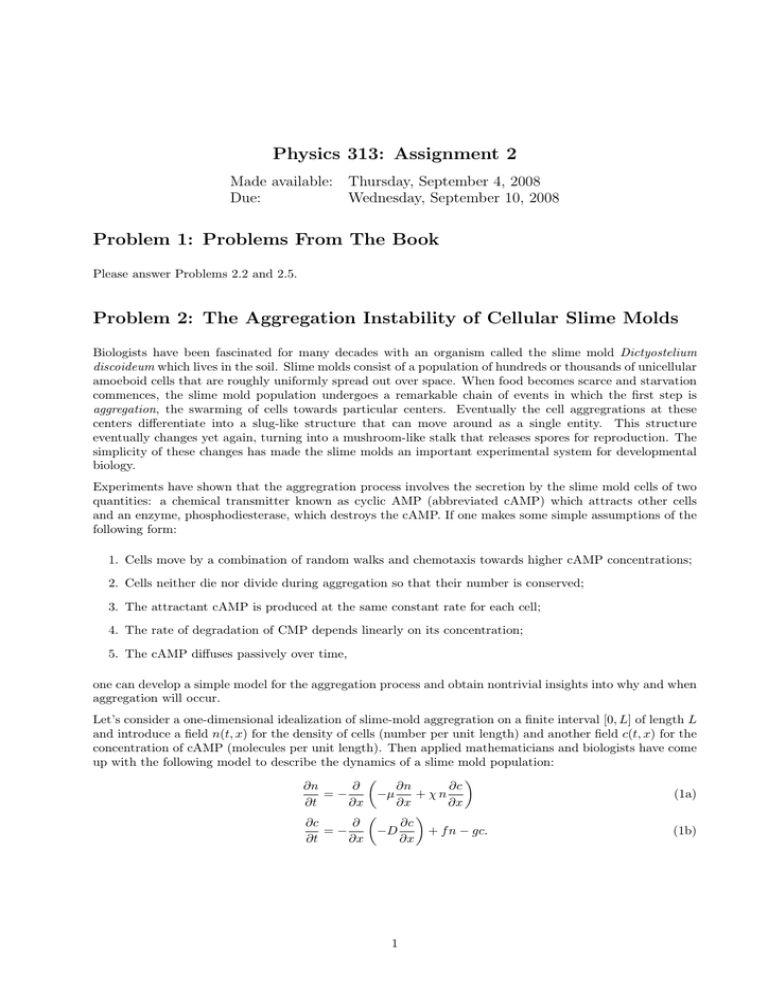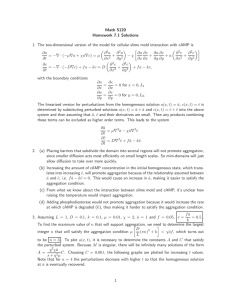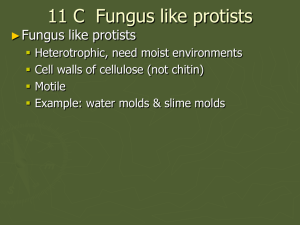Physics 313: Assignment 2 Problem 1: Problems From The Book
advertisement

Physics 313: Assignment 2 Made available: Thursday, September 4, 2008 Due: Wednesday, September 10, 2008 Problem 1: Problems From The Book Please answer Problems 2.2 and 2.5. Problem 2: The Aggregation Instability of Cellular Slime Molds Biologists have been fascinated for many decades with an organism called the slime mold Dictyostelium discoideum which lives in the soil. Slime molds consist of a population of hundreds or thousands of unicellular amoeboid cells that are roughly uniformly spread out over space. When food becomes scarce and starvation commences, the slime mold population undergoes a remarkable chain of events in which the first step is aggregation, the swarming of cells towards particular centers. Eventually the cell aggregrations at these centers differentiate into a slug-like structure that can move around as a single entity. This structure eventually changes yet again, turning into a mushroom-like stalk that releases spores for reproduction. The simplicity of these changes has made the slime molds an important experimental system for developmental biology. Experiments have shown that the aggregration process involves the secretion by the slime mold cells of two quantities: a chemical transmitter known as cyclic AMP (abbreviated cAMP) which attracts other cells and an enzyme, phosphodiesterase, which destroys the cAMP. If one makes some simple assumptions of the following form: 1. Cells move by a combination of random walks and chemotaxis towards higher cAMP concentrations; 2. Cells neither die nor divide during aggregation so that their number is conserved; 3. The attractant cAMP is produced at the same constant rate for each cell; 4. The rate of degradation of CMP depends linearly on its concentration; 5. The cAMP diffuses passively over time, one can develop a simple model for the aggregation process and obtain nontrivial insights into why and when aggregation will occur. Let’s consider a one-dimensional idealization of slime-mold aggregration on a finite interval [0, L] of length L and introduce a field n(t, x) for the density of cells (number per unit length) and another field c(t, x) for the concentration of cAMP (molecules per unit length). Then applied mathematicians and biologists have come up with the following model to describe the dynamics of a slime mold population: µ ¶ ∂n ∂ ∂n ∂c =− −µ + χn (1a) ∂t ∂x ∂x ∂x µ ¶ ∂ ∂c ∂c =− −D + f n − gc. (1b) ∂t ∂x ∂x 1 The various parameters have the following meanings: µ = amoeboid motility, (2a) χ = chemotactic coefficient, (2b) D = diffusion rate of cAMP, (2c) f = secretion rate of cAMP per unit density of amoebae, (2d) g = degradation rate of cAMP in the environment. (2e) Yet another simplification that we will make is that these quantities are all constants, independent of changes in the fields n and c. As pdes involving second-order spatial derivatives, only one condition on each field is needed at each boundary point. For slime mold in soil, it is unclear would be good boundary conditions. For slime mold in an experimentalist’s Petri dish, a convenient choice mathematically would be that neither cells nor cAMP can leave the domain of interest, i.e., the no-flux conditions given by: ∂n = 0, ∂x ∂c = 0, ∂x at x = 0, x = L, (3a) at x = 0, x = L. (3b) Please answer the following questions: 1. Derive and give a mathematical expression for a nonzero spatially uniform fixed-point solution of (1), n = n0 and c = c0 , and explain what this solution means scientifically. Is your solution unique? 2. For an infinite system size L = ∞, use a linear stability analysis around the nonzero homogeneous state to show that instability will occur when the following criterion is satisfied: ¡ ¢ µ Dq 2 + g < χ n0 f, (4) for any wavenumber q of a Fourier mode perturbation of the form exp(iqx). A reasonable conjecture is that this instability corresponds to the beginning of aggregration. 3. By thinking about (4), discuss what biological conditions will encourage aggregration: large diffusion constants D? Small amoeboid motility µ? Large rates of cAMP secretion f ? 4. What type of instability is this, e.g., type Is or type IIIo ? If it occurs at a finite-wavelength, give an explicit expression for the critical wavenumber qc . It would be interesting to plug in experimental estimates of the model parameters and see how good the agreement is. 5. The main effect of considering a finite-size domain of length L with bcs (3) is that the perturbation wavenumbers k become quantized, k = nπ/L for n an integer. Substituting these quantized wavenumbers into the aggregation criterion (4), discuss whether aggregration is more likely or not as the system size L becomes smaller. Will the low- or high-mode numbers n become unstable first? 6. Based on your linear stability analysis and your discussion of what happens with finite boundaries, predict in some detail what a biologist might observe at the onset of aggregration of slime mold cells in a Petri dish. 7. Extra credit: As is the case for any linear stability analysis, a direct numerical simulation of (1) would be greatly insightful about how the instability evolves into the nonlinear regime and what the long-time dynamics will be. Are there stationary inhomogeneous solutions? Are there time-dependent attractors? 2 Problem 3: Time To Complete This Assignment Please tell me the approximate time in hours that it took you to complete this assignment. Please also give me any comments that you might have about the course so far: are the lectures understandable and useful? Are the level and pace of the course appropriate? Are the homework problems helping you to learn the material? Do you have any recommendations to improve the course? 3








